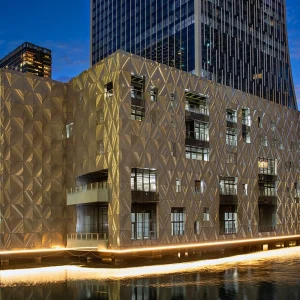
Our new office in Tottenham is, at one level, a clear demonstration of our continuing belief that architecture can help change people’s lives and architects have a direct social responsibility. This obligation was so clear in the corpus of work developed by architects and planners in the immediate aftermath of the Second World War in response to its devastating damage to urban fabric and civic morale, and was essentially a commitment to aim to provide our citizens with a decent built environment. Enlightened and essentially democratic, this modernist ideal sought to sweep away pre-war concepts of social hierarchy, offering better working and living conditions for all.
The idea for a new studio in Tottenham came out of a discussion between Nick Walkley, chief executive of Haringey Council, John McAslan and myself. In July 2013, Nick invited us to come to Tottenham and see the challenges facing the council in terms of urban regeneration for ourselves.
The resulting idea to embed ourselves in the High Road — as it turned out almost immediately opposite the police station where the riots started — was an immediate response that followed naturally from our experience in Haiti, Malawi and India. What better way to reach out and engage with the local community and, more importantly, to establish credibility? In these circumstances, you can’t be a tourist if you really want to understand the social and urban context and be an agent of change.
The new studio will offer young people in Tottenham a range of opportunities such as internships and work placements — giving them an insight into the way a design studio operates and, hopefully, encouraging them to explore career opportunities in the sector. As a practice, this new venture provides a valuable opportunity to assess the area’s immediate need for regeneration, and is precisely the kind of pragmatic engagement advocated in the late Nineties by the Urban Task Force Report, Towards an Urban Renaissance. Commissioned by a Labour government and chaired by Lord Rogers, the report identified the urgent need to revitalise hitherto neglected inner-city areas. The sobering reality is that, some 14 years later, these problems have not retreated and, in the case of Tottenham, have indeed intensified as is clearly evident when you walk the streets and see the effects of unemployment and urban deprivation on the local community.
In some regards, the N17 Design Studio offers a new paradigm of an engaged, participatory and socially relevant architecture practice. The recent boom-and-bust cycles of urban speculation have often reduced architecture to just another material commodity to make money. In this mode, design has become an asset to be traded in the markets, and architecture per se has lost its moral compass. It has lost its fundamental connection with real people, real communities, real need and with this, the essential concern and obligation to promote equality and make the benefits of design available to everyone.
We believe that the gradual adoption of this morally neutral, ‘architecture and design as good business’ philosophy has led artists and architects to their currently marginalised status in society. Architecture is no longer a fundamental tool of social progress but rather only a means to create and celebrate wealth for the benefit of a relatively small and privileged few.
The challenges of regeneration in Tottenham after the riots, after years of neglect, after the decline of local services, community support and the economic downturn, are enormous and complex. But this complexity needs to be understood and debated on the ground and within a local community that has been badly served by the design profession in recent years. It’s our intent at N17 to bring architecture back into a more vernacular, everyday world, taking it out of the rarefied and remote sphere of professionalism. At the very least, we aim to become a legitimate part of a community trying to rebuild and express itself as one of London’s most diverse and authentic neighbourhoods.
Our hope is that, by applying a lighter, more participatory design approach than that of our modernist forebears, we can help in some small way to promote growth and gradual improvements to areas such as Tottenham. The proof of the pudding is in the eating — I believe an initiative such as our N17 Design Studio is not the only way for architects to engage in regeneration, but in some regards artists and architects are always pioneers of regeneration, and we hope in time many others will join us in Tottenham.
John McAslan + Partners has set up an office – N17 Design Studio – in the heart of Tottenham, north London, to engage with the community and help regenerate the area from within. Its director for urban design, Aidan Potter, also the N17 Design Studio project director, argues that architects have become marginalised — they need to regain the moral high ground and become agents for change rather than simply profit





